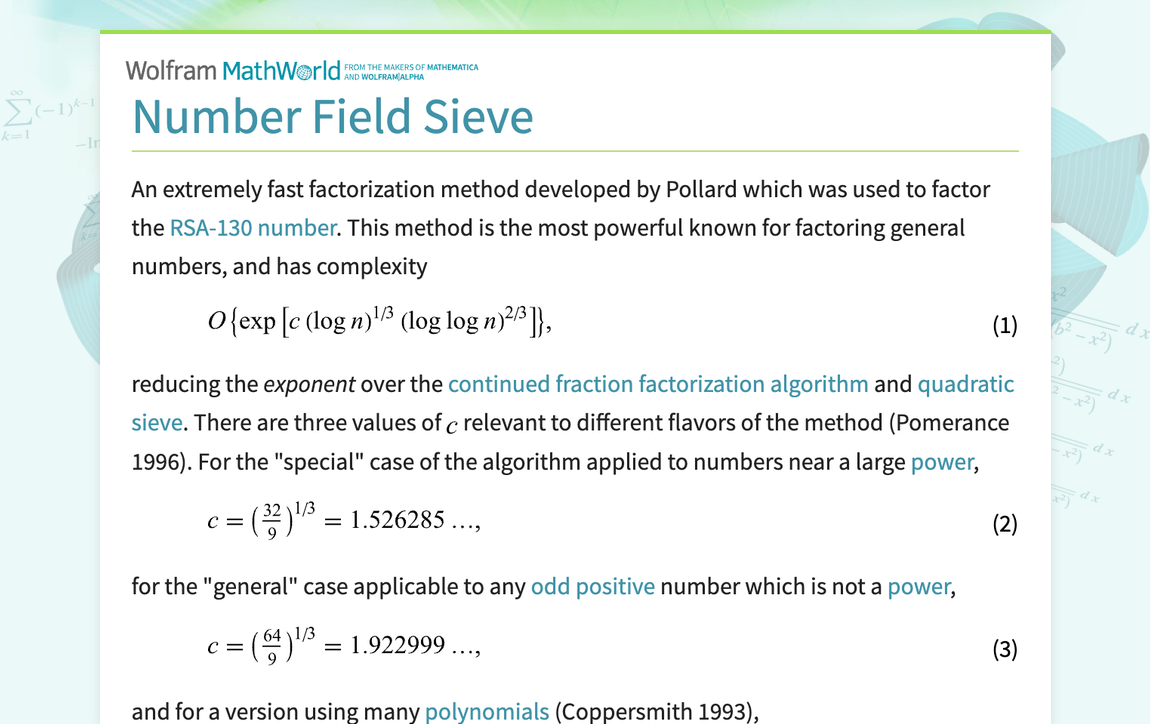
mathworld.wolfram.com/NumberFieldSieve.html
Preview meta tags from the mathworld.wolfram.com website.
Linked Hostnames
5- 31 links tomathworld.wolfram.com
- 4 links towww.amazon.com
- 4 links towww.wolfram.com
- 4 links towww.wolframalpha.com
- 1 link towolframalpha.com
Thumbnail

Search Engine Appearance
Number Field Sieve -- from Wolfram MathWorld
An extremely fast factorization method developed by Pollard which was used to factor the RSA-130 number. This method is the most powerful known for factoring general numbers, and has complexity O{exp[c(logn)^(1/3)(loglogn)^(2/3)]}, (1) reducing the exponent over the continued fraction factorization algorithm and quadratic sieve. There are three values of c relevant to different flavors of the method (Pomerance 1996). For the "special" case of the algorithm applied to numbers...
Bing
Number Field Sieve -- from Wolfram MathWorld
An extremely fast factorization method developed by Pollard which was used to factor the RSA-130 number. This method is the most powerful known for factoring general numbers, and has complexity O{exp[c(logn)^(1/3)(loglogn)^(2/3)]}, (1) reducing the exponent over the continued fraction factorization algorithm and quadratic sieve. There are three values of c relevant to different flavors of the method (Pomerance 1996). For the "special" case of the algorithm applied to numbers...
DuckDuckGo
Number Field Sieve -- from Wolfram MathWorld
An extremely fast factorization method developed by Pollard which was used to factor the RSA-130 number. This method is the most powerful known for factoring general numbers, and has complexity O{exp[c(logn)^(1/3)(loglogn)^(2/3)]}, (1) reducing the exponent over the continued fraction factorization algorithm and quadratic sieve. There are three values of c relevant to different flavors of the method (Pomerance 1996). For the "special" case of the algorithm applied to numbers...
General Meta Tags
22- titleNumber Field Sieve -- from Wolfram MathWorld
- DC.TitleNumber Field Sieve
- DC.CreatorWeisstein, Eric W.
- DC.DescriptionAn extremely fast factorization method developed by Pollard which was used to factor the RSA-130 number. This method is the most powerful known for factoring general numbers, and has complexity O{exp[c(logn)^(1/3)(loglogn)^(2/3)]}, (1) reducing the exponent over the continued fraction factorization algorithm and quadratic sieve. There are three values of c relevant to different flavors of the method (Pomerance 1996). For the "special" case of the algorithm applied to numbers...
- descriptionAn extremely fast factorization method developed by Pollard which was used to factor the RSA-130 number. This method is the most powerful known for factoring general numbers, and has complexity O{exp[c(logn)^(1/3)(loglogn)^(2/3)]}, (1) reducing the exponent over the continued fraction factorization algorithm and quadratic sieve. There are three values of c relevant to different flavors of the method (Pomerance 1996). For the "special" case of the algorithm applied to numbers...
Open Graph Meta Tags
5- og:imagehttps://mathworld.wolfram.com/images/socialmedia/share/ogimage_NumberFieldSieve.png
- og:urlhttps://mathworld.wolfram.com/NumberFieldSieve.html
- og:typewebsite
- og:titleNumber Field Sieve -- from Wolfram MathWorld
- og:descriptionAn extremely fast factorization method developed by Pollard which was used to factor the RSA-130 number. This method is the most powerful known for factoring general numbers, and has complexity O{exp[c(logn)^(1/3)(loglogn)^(2/3)]}, (1) reducing the exponent over the continued fraction factorization algorithm and quadratic sieve. There are three values of c relevant to different flavors of the method (Pomerance 1996). For the "special" case of the algorithm applied to numbers...
Twitter Meta Tags
5- twitter:cardsummary_large_image
- twitter:site@WolframResearch
- twitter:titleNumber Field Sieve -- from Wolfram MathWorld
- twitter:descriptionAn extremely fast factorization method developed by Pollard which was used to factor the RSA-130 number. This method is the most powerful known for factoring general numbers, and has complexity O{exp[c(logn)^(1/3)(loglogn)^(2/3)]}, (1) reducing the exponent over the continued fraction factorization algorithm and quadratic sieve. There are three values of c relevant to different flavors of the method (Pomerance 1996). For the "special" case of the algorithm applied to numbers...
- twitter:image:srchttps://mathworld.wolfram.com/images/socialmedia/share/ogimage_NumberFieldSieve.png
Link Tags
4- canonicalhttps://mathworld.wolfram.com/NumberFieldSieve.html
- preload//www.wolframcdn.com/fonts/source-sans-pro/1.0/global.css
- stylesheet/css/styles.css
- stylesheet/common/js/c2c/1.0/WolframC2CGui.css.en
Links
44- http://www.amazon.com/exec/obidos/ASIN/0387570136/ref=nosim/ericstreasuretro
- http://www.amazon.com/exec/obidos/ASIN/0444880712/ref=nosim/ericstreasuretro
- http://www.amazon.com/exec/obidos/ASIN/3540618724/ref=nosim/ericstreasuretro
- http://www.wolframalpha.com/input/?i=prime+factorization
- https://mathworld.wolfram.com